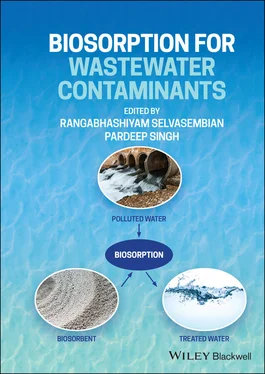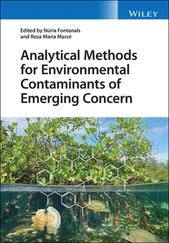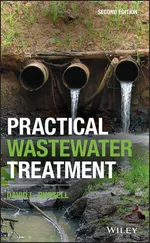That being said, toxic heavy metals are a subgroup with harmful effects leading to poisoning and bio‐intoxication. Some of them are dangerous at extremely low levels. For instance, the general effects of cadmium exposure in humans have been reported as renal and gastrointestinal symptoms since the body tries metabolize and eliminate the substance. However, fumes and dust can cause high levels of cadmium exposure, which compromises the respiratory tract and causes coughing and chest pain because the lungs may fill with watery fluids; the result is a high risk of death. On the other hand, long‐term, low‐dose exposure can be associated with osteoporosis, myocardial dysfunctions, proteinuria, and higher blood pressure (Hallenbeck, 1986; Duruibe et al., 2007). This metal is commonly associated with high‐tech and power‐generation components, such as batteries, alloys, solar cells, pigments, and neutron absorbers in nuclear reactors. It is also used in the automotive industry due to its corrosion resistance. Since it inhibits organism growth, like many heavy metals, it is found in phosphate fertilizers as well (Sharma et al., 2015).
Arsenic is a harmful metalloid widely distributed around the world through natural and human activities. In reported long‐term, low‐dose exposure, victims suffer from skin lesions, neuropathy, diabetes, cardiovascular diseases, and cancer of the skin and internal organs (WHO 2019). Arsenic can be found in drinking water, industrial processes, food, and various tobacco products. In the industrial sector, wastewaters from pesticide, glass, and pharmaceutical manufacturing may contain the metalloid, but microelectronics and optical industries also handle arsenic compounds. Arsenic has been historically used in the agricultural sector as a pesticide, an insecticide, a defoliant, and a desiccant. However, due to its high biotoxicity, the United States Environmental Protection Agency (EPA) has banned its application in crops. Furthermore, elemental arsenic is used in alloys with copper and lead, while gallium arsenide and arsine have high electron mobility and are used in superconductors, magnets, light‐emitting and chips, and many other applications in the electronic industries.
On the other hand, lead is not a good electric conductor. It is used in construction, ammunition, metallic alloys, cable sheaths, lead‐acid batteries, pigments, fuses, and X‐ray and radiation protection. Lead‐contaminated potable water causes various undesirable effects, such as anemia, kidney and brain damage, infertility, miscarriage, and changes in behavior (hypersensibility, impulsivity, and aggressiveness). Despite oral exposure being the most common, anal, dermal, respiratory, and genital routes are also possible and result in the same kind of effects. This metal is well known for its chronic toxicity, easily damaging the central nervous system even at very low doses. In acute poisoning, the person shows signs of muscle weakness, pain, diarrhea, constipation, weight loss, bloody urine, etc. In industrial wastewaters, lead concentration ranges from 200 to 500 mg/L. According to WHO and EPA standards, its levels must be critically reduced to achieve 0.05–0.10 mg/L before discharge (Arbabi et al., 2015). In order to mitigate lead pollution, several methods for industrial wastewater treatment have been adopted, such as precipitation, adsorption, ion exchange, reverse osmosis, coagulation, and electro‐coagulation (Arbabi et al., 2015).
Mercury, the only toxic metal present in liquid form at ambient temperature, is found in all living things and plays a crucial biological role. Nevertheless, it must remain at low levels, otherwise leads to toxic effects. The usual symptoms for acute exposure are fever, diarrhea, and vomiting, while chronic exposure causes tremors, nausea, stomatitis, pink disease, parageusia, and kidney malfunctions. Historically, gold amalgam (mercury alloy) was commonly used for gilding in architecture and fine arts. For example, in Saint Petersburg, Russia, at least 60 workers died from gilding the main dome of Saint Isaac's Cathedral (Emsley, 2011). Nowadays, industrial waters containing mercury are usually associated with dental care, paints, and fertilizers, but landfill leachate must also be considered mercury‐containing waste (Hargreaves et al., 2016).
There are other toxic metal compounds of great concern, such as hexavalent chromium and copper. However, these chemicals were not included in the WHO list due to fewer cases compared to the ones previously mentioned. Many of them are also genotoxic gastrointestinal disruptors and are found in fertilizers and biocide compositions. Consequently, industrial wastewater containing toxic metals must be properly treated in order to not expose humans and other animals to harmful health impacts.
Toxic heavy metals have been part of human life for quite some time; hence there have been several attempts to find the best method to effectively remove them from industrial wastewater. Conventional methods including chemical, physical, and biological mechanisms have been adopted. For inorganic wastewater, chemical precipitation and ion exchange have been most widely used, but more recent advances have shown promising results using adsorption, electrodialysis, membrane filtration, and photocatalysis (Barakat, 2011). It is noteworthy that biosorption has also shown high efficiency for removing and recovering metals from wastewater, in addition to being a much cleaner and more cost‐effective alternative (Kurniawan et al., 2006; Calderón et al., 2020).
Taking note of the facts and trends regarding toxic heavy metals, proper management of industrial wastewater must be taken into consideration. Each type of industry brings its own complexity and selected metals due to its manufacturing processes, as well as other constituents that must be treated before effluent discharge.
Dyes are strongly related to toxic metals, given that they may contain such chemicals, and must be addressed. Some of their negative effects are inhibiting photosynthesis and plant growth, toxicity, carcinogenicity, mutagenicity, persistence, and recalcitrance. In addition, they increase biochemical oxygen demand (BOD) and chemical oxygen demand (COD) in industrial wastewaters (Lellis et al., 2019), which leads to further treatment expenditures. These wastewater contaminants are soluble organic compounds; because of the presence of chromophoric groups (azo, carbonyl, nitro, methine, etc.) in their molecules, it is hard to remove them from solution by conventional methods due to the presence of hydrophilic groups such as auxochromes.
Since such substances are used to color solid structures, when disposed in water bodies, they block the penetration of solar rays and reduce photosynthesis activity, which leads to lower dissolved oxygen levels and compromises aquatic life and self‐purification processes. As a result, dye‐containing industrial wastewater requires efficient methods to eliminate this chain of negative impacts throughout ecosystems.
Dyes can be manufactured from artificial and organic materials. Synthetic dyes are usually derived from petroleum and contain various toxic chemicals. Despite natural dyes being much more biodegradable and environmentally friendly, they must be mixed with a mordant , a kind of binding agent that helps attach dyes to fabrics. According to Katheresan et al. (2018), such binding agents may be more dangerous than synthetic dyes alone.
Over 800,000 tons of synthetic dyes are produced annually worldwide and generate around 1 trillion US dollars (Hassaan and El Nemr, 2017; Lellis et al., 2019). However, the manufacturing processes make them recalcitrant (resistant to biological degradation), and this is one of the most water‐consuming sectors. For example, 1 kg of dye produced normally requires 0.15 m 3of water. Unfortunately, over 200,000 tons of these dyes are lost during coloring processes and are carried in wastewater (Chequer et al., 2012), implying an unsustainable situation. The primary use of dyes is in the textile industries, but they are also present in the paper, tannery, food, pharmaceutical, and cosmetic industries, as shown in Figure 1.1.
Читать дальше












